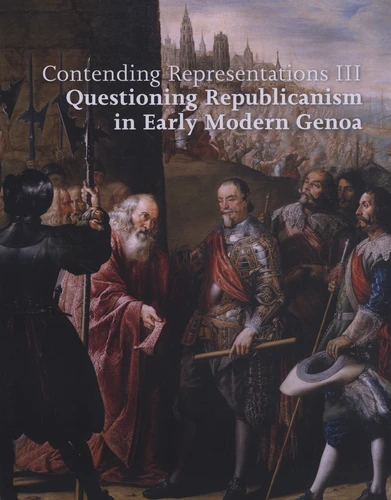Contending Representations. Volume 3, Questioning Republicanism in Early Modern Genoa
Par : ,Formats :
- Paiement en ligne :
- Livraison à domicile ou en point Mondial Relay indisponible
- Retrait Click and Collect en magasin gratuit
- Réservation en ligne avec paiement en magasin :
- Indisponible pour réserver et payer en magasin
- Nombre de pages193
- PrésentationRelié
- FormatGrand Format
- Poids1.12 kg
- Dimensions22,5 cm × 29,0 cm × 2,0 cm
- ISBN978-2-503-60521-0
- EAN9782503605210
- Date de parution01/01/2024
- CollectionDunamis
- ÉditeurBrepols
Résumé
Several studies have been devoted to the flowering of the republic of Genoa during the so-called 'siglo de los Genoveses, when Genoa became the hub of European trade and an important center of artistic and literary production. Yet, little attention has been granted to the political and cultural crisis that followed, starting in 1559 and culminating in 1664, when the French bombed Genoa. Addressing this chronological gap, the volume explores how the image of the Genoese Republic was shaped, exploited, or contested in the long seventeenth century.
How did Genoese politicians and men of letters represent their homeland ? How was Genoa represented in Spain or in the Low Countries ? How was its political system conceived by Italian and foreign political writers, and how did the prevailing absolutist model influence such ideas ? In order so answer these questions, the volume gathers contributions from art historians, literary scholars, political and cultural historians, thus adopting a comparative, multidisciplinary approach.
How did Genoese politicians and men of letters represent their homeland ? How was Genoa represented in Spain or in the Low Countries ? How was its political system conceived by Italian and foreign political writers, and how did the prevailing absolutist model influence such ideas ? In order so answer these questions, the volume gathers contributions from art historians, literary scholars, political and cultural historians, thus adopting a comparative, multidisciplinary approach.
Several studies have been devoted to the flowering of the republic of Genoa during the so-called 'siglo de los Genoveses, when Genoa became the hub of European trade and an important center of artistic and literary production. Yet, little attention has been granted to the political and cultural crisis that followed, starting in 1559 and culminating in 1664, when the French bombed Genoa. Addressing this chronological gap, the volume explores how the image of the Genoese Republic was shaped, exploited, or contested in the long seventeenth century.
How did Genoese politicians and men of letters represent their homeland ? How was Genoa represented in Spain or in the Low Countries ? How was its political system conceived by Italian and foreign political writers, and how did the prevailing absolutist model influence such ideas ? In order so answer these questions, the volume gathers contributions from art historians, literary scholars, political and cultural historians, thus adopting a comparative, multidisciplinary approach.
How did Genoese politicians and men of letters represent their homeland ? How was Genoa represented in Spain or in the Low Countries ? How was its political system conceived by Italian and foreign political writers, and how did the prevailing absolutist model influence such ideas ? In order so answer these questions, the volume gathers contributions from art historians, literary scholars, political and cultural historians, thus adopting a comparative, multidisciplinary approach.


